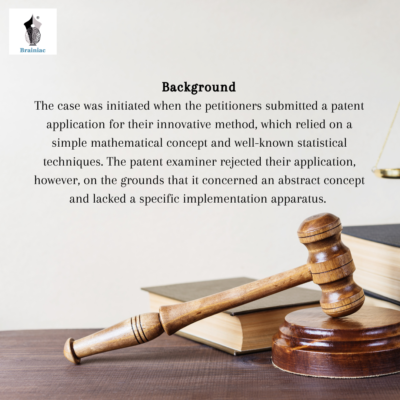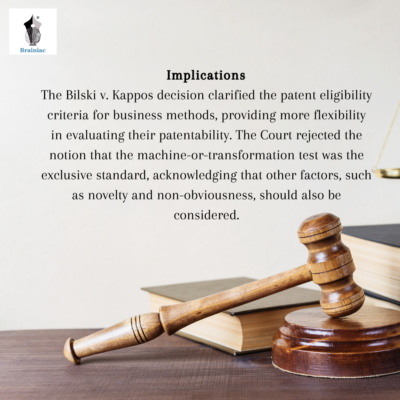Introduction
In a landmark case that has far-reaching implications for patent law, the United States Supreme Court recently issued a significant ruling on the test for patent eligibility under Section 101 of the Patent Act. Section 101 of the U.S. Patent Act is a fundamental provision that defines the scope of patent eligibility. It establishes the categories of inventions that are considered patentable subject matter.
The petitioners in the case sought a patent for their method of hedging against energy market price fluctuations. The patent examiner rejected their application, deeming it an abstract idea that lacked implementation on a specific apparatus. This decision was subsequently affirmed by the Federal Circuit. However, the Supreme Court’s verdict brings forth a new perspective on the matter.
Background
The case was initiated when the petitioners submitted a patent application for their innovative method, which relied on a simple mathematical concept and well-known statistical techniques. The patent examiner rejected their application, however, on the grounds that it concerned an abstract concept and lacked a specific implementation apparatus. Using the machine-or-transformation test, the Federal Circuit subsequently upheld this ruling. According to this criterion, a process may be patentable if it is linked to a specific machine or transforms an item into something else.
The Dissenting Opinions
Within the Federal Circuit, there were dissenting opinions. One judge argued that the method failed because it constituted a business method. Another judge contended that the invention was an abstract idea and, therefore, unpatentable. A third dissenter suggested remanding the case to determine patentability under other provisions. These diverging viewpoints highlight the complexity and contentiousness of the issue.
Supreme Court Verdict
The Supreme Court, in a majority decision authored by Justice Kennedy, held that the machine-or-transformation test was not the sole test for patent eligibility under Section 101 of the Patent Act. While the Court acknowledged the importance of the test, it emphasized that Section 101 defines patent eligibility with exceptions for laws of nature, physical phenomena, and abstract ideas. Moreover, the Court pointed out that the Federal Circuit’s adoption of the machine-or-transformation test as the exclusive criterion for defining a “process” was unnecessary and potentially restrictive.
The Court emphasized that the test’s exclusivity could create uncertainty for patentability in emerging technologies, including computer software. It clarified that the definition of “process” in Section 100(b) did not exclude business methods, and federal law explicitly contemplated the patentability of certain business method patents. The Court emphasized that the requirements of novelty, non- obviousness, and full description acted as safeguards against unjustified patents.
However, the Court also acknowledged that the petitioners’ process might not meet the requirements of Section 101 as it claimed an abstract idea. The Court’s precedent supported the limitation that abstract ideas should not be patentable.
Concurring Opinions
Justice Stevens concurred with the majority but expressed concerns about the breadth of the majority’s reasoning. While agreeing that the machine-or-transformation test was not the sole test for patentability, he believed that the method in question was not a “process” because it merely described a general method of conducting business. He argued that business methods should not be patentable based on historical norms, legislative intent, and the adverse impact on innovation and competition.
Justice Breyer’s concurrence highlighted key points of agreement among the Justices. He emphasized that while the machine-or-transformation test was useful and important, it had never been the sole test for patentability. Furthermore, he clarified that the presence of a useful, concrete, and tangible result did not automatically make an invention patentable.
Implications
The Bilski v. Kappos decision clarified the patent eligibility criteria for business methods, providing more flexibility in evaluating their patentability. The Court rejected the notion that the machine-or-transformation test was the exclusive standard, acknowledging that other factors, such as novelty and non-obviousness, should also be considered.
This ruling had both supporters and detractors within the patent community. Supporters appreciated the increased flexibility for patent applications, particularly for business method inventions that did not strictly meet the machine-or-transformation test. Detractors expressed concerns about a potential flood of process claims, including services like legal counseling and arbitration, and desired more definitive guidelines on appropriate business method patents.
Scenario in India
Section 3(k) of the Indian Patent Act states that “a mathematical or business method or a computer program per se or algorithms” are not inventions and, therefore, not patentable. This provision explicitly excludes mathematical algorithms from patentability, emphasizing the legislative intent to prevent the monopolization of abstract mathematical concepts.
However, the interpretation and application of Section 3(k) have been the subject of debate and controversy. There have been instances where applicants sought to patent algorithms integrated into specific applications or processes, arguing that the inventive step lies in the practical implementation rather than the algorithm itself.
In the landmark case of Ferid Allani v. Union of India (2004), the Indian Supreme Court clarified that mathematical methods, algorithms, and computer programs as such are non-patentable. The Court emphasized that the exclusion extends to the “essence” of a mathematical algorithm, even if it is claimed as part of a broader invention or application.
It is worth noting that the exclusion of mathematical algorithms does not preclude/prevent patent protection for inventions that utilize mathematical algorithms as a part of a larger inventive concept. If an invention incorporates a technical solution or demonstrates a tangible application beyond the algorithm itself, it may still be eligible for patent protection.
In recent years, there have been ongoing discussions and debates regarding the scope of patentability for computer-related inventions, including software and algorithms. The Indian Patent Office and the judiciary have been striving to strike a balance between encouraging innovation and preventing the undue monopolization of abstract ideas.
Conclusion:
The case marked a significant milestone in patent law, specifically regarding the patent eligibility of business methods. The Supreme Court’s decision clarified that the machine-or-transformation test is not the sole determinant of patentability under Section 101. By recognizing the broader requirements of novelty, non- obviousness, and full description, the Court provided a more comprehensive framework for evaluating the patent eligibility of business method inventions.






